Erik Brown: Accounts from Thailand’s cave rescue Part 2
The rescue of the century took place June 23, 2018 in Thailand. The lives of twelve Thai boys and their coach were saved by a group of scuba divers, throwing diving into the global limelight, and captivating the world. One of the rescue divers sat down and told us about his part in the rescue…
Part 2 – Interview by Russell Clark

DIVER: When did they decide ‘now’…
Erik: At this point in time we were running out of options. Drilling wasn’t an option. Leaving them in wasn’t an option and swimming them out also wasn’t an option. With the rains only a few days away, there was little choice left.
As I said before, even the very rare examples of cave rescues before involved rescuing a person already trained in cave diving, not 13 boys who can’t swim. Panic was easily the biggest danger both the kids and the rescue divers faced. If the kids panicked – it was game over. And them panicking was a 100% certainty. The only way to possibly make it happen was to pretty much fully sedate the kids.
Obviously, they’d be unable to hold a regulator in their mouth, so specialized full face masks were tweeked to postive pessure (pretty much minor freeflowing) to allow the sedated kids to breathe with lower respitory rates.
The masks aren’t deisgned for 13 year-old Thai boys. After a successful day in a local pool testing the equipment on some local kids, it became a bit more apparent that the idea might work.
It says something when sedating a bunch of kids, tying them up, and dragging them 4km [2.5 miles] out of a cave is the best option. It proves how absolute shit the alternatives were if this was the best choice of action. It may seem logical now in hindsight, but at the time it seemed pretty messed up.
So much thought went into it, to the point where the kids were going to drool when sedated, drool into the masks, so they actually gave them another drug to reduce the saliva buildup. It was quite phenomenal as we went through the thought process. They thought of everything to the best they could. Dr. Harris and the team did some amazing work.
Were their eyes open?
Sleep is probably a good word to describe the state the kids were in. There was slight movement most times to be fair. They were face down in the water with the configuration set up, and we only really pulled them out when we needed to change tanks. We would pull them out, take the mask off because there was no exhaust valve on it – which was actually quite an ordeal, you had to have one person supporting the kid, one changing tanks. It was a two of three person job to get some of these simple things done.
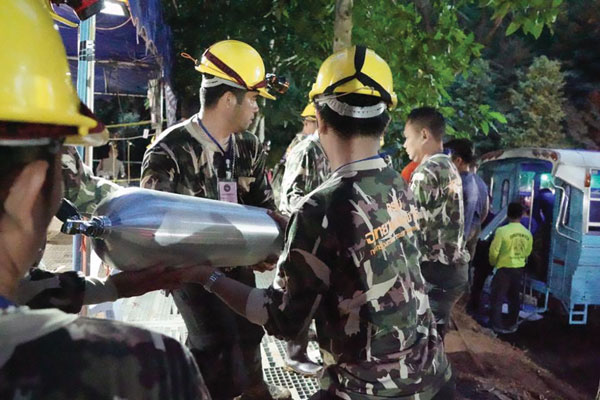
Did the kids have any kind of BCD?
They had kinda an oral inflate Navy flotation device. Kinda like a snorkel vest, they had it strapped to their front.
How were the kids positioned?
We needed to make sure they were sedated but not too sedated so they wouldn’t be able to breathe, which is why they used a special mix including ketamine and few other things; as I said, they thought of everything. But because that drug only lasts a limited time, we had to re-administer it as they worked through the cave, which is where I could assist as a support diver in the cave. We had small medical stations set up and would inject the kids if needed. I don’t think I need to explain that this is outside my normal skill set.
Obviously we were worried that they would panic if they woke up, there are so many different line traps and rocks. We didn’t want their arms get caught as the came through so we had their arms and feet tied, and the actual tank was bungeed to their stomach. They were lying face down with flotation on their chest, full face mask with the tank on the their chest, and then their hands tied together and their feet tied together.
In the part of the cave where I was, I’d be standing next to them dragging them. They had a handle almost on their shoulder blades. But for some of the restrictions they’d have to be put in front of the diver at times, or below, or off to the side. It required constant adjustment.
Did it get easier?
Just because the first four made it, it doesn’t give you any higher or lower odds of being successful with the others. Subconsciously you realize the plan works, so you are more optimistic. But all it takes is for one wrong move – bump a kid’s head and the mask floods and it’s game over. So the inherent risk for each child didn’t diminish at all. After each day you don’t celebrate too much as it’s equally as dangerous on 2 as day 3.
Each child would be given one primary diver who would be with them from the beginning to the end; they would know exactly how much drugs they’d have, they could monitor the gas better, and deal with the welfare of the child easier. Some dry sections where the kids came up, we would put him on a stretcher and carry him across 150m [450 feet] of dry land inside the cave, and put him back in the water. The primary rescue diver would be taking his own tanks off and walking across to get back in at the same time.
My section in chamber six was about 150m [500ft] long and in a position where we had to deal with quite a few gas changes. We had a muddy little mound to one side where I could sit while waiting. I was either simply moving the kids along to give the primary divers a much needed break, administering the sedation, changing tanks, or a combination of all three. The idea was the child would never have to stop, if the primary was changing his tanks, I was moving forward and he would catch up, give him a handshake, and send him on his way until he pops out 50m [150 feet] on the other side where there’s another support diver waiting for him. It was a relay.
The hardest part is the lack of communication, which adds such a massive stress onto this. You can put it all on a timer, but sometimes it takes half an hour longer to swim based on flow. You’re sitting there waiting and know the kids should be arriving around this time, but they were two and half hours late on the first day, you’re sitting there going, “Something’s definitely not right.” But some things take longer. The swim in with the extra gear for the kids, it’s the first time they’ve put gear on the kids – they were putting them into wetsuits because they were worried about hypothermia – they’re going a little slower because it is the first time. But you’re sitting there two hours later and you can only think something has gone massively wrong. You’re in control of that 150m [500ft] gap, but as soon as they leave you, that kid has another two hours of diving and one hour hiking, and you don’t know if they made it.
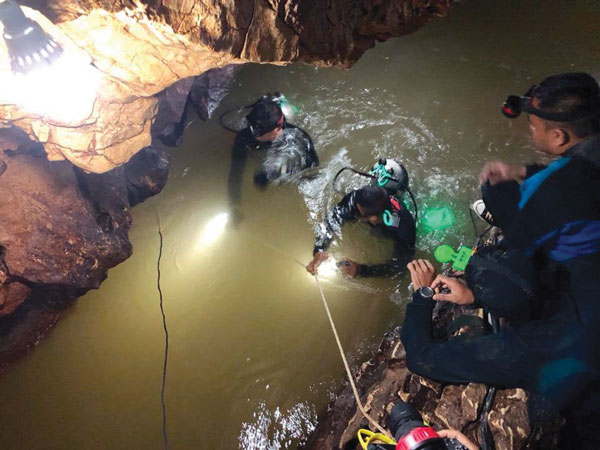
Could the communication problems be solved?
Towards the end they ran fibre optics into chamber three so they could communicate with the military, but no traditional dive comms would work. Radio had to be hard-wired in and that would have just become another entanglement hazard.
I remember when you popped your head out of the water at the end of the day, you could tell everyone was super experienced at what they do, they didn’t pounce on you. You’d take your helmet off and pass it to them, then there’d be 30 seconds of complete silence and you’d look at them and say, “Give it to me.” They’d say, “3 for 3”, or “4 for 4”.
What did you think when you first saw a kid coming towards you?
Ah man. It is a movie-like moment that you’ll never forget because it was so surreal. Jason was the first diver to come through. I remember how slow he was walking. Strategic. These guys are so meticulous and so in control. There’s no rush, no anxiety. You’re thinking they don’t need to rush because either everything is fine, or because the kid is dead already and it doesn’t matter. You see this silhouette with water up to the waist and a cave light behind them just slowly coming up to you and then you see the bubbles come from the kid’s mask underwater and you’re like, fuck! This is actually going to work. It will be etched in my memory forever.
What do you do when you are in the water for hours at a time?
The idea was to have about 30 – 45 minutes between each kid. The first couple went as planned but then we had 1 hour and 45 minute gap. You think something’s wrong. You’re in pairs so you’re talking, but your focus is on this dark corridor. Your eyes are playing tricks on you, you keep thinking you see spots of light and there are little drips of water coming from the cave roof that are echoing through. It’s a very exhausting place to be sitting for eight hours.
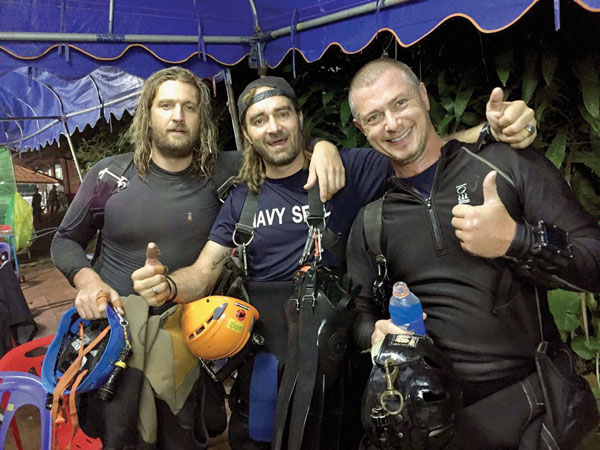
What were the kids, and you guys, breathing?
For most divers it’s like nails on a chalkboard when the mainstream media says “oxygen tanks”! I saw a lot of divers on social media saying, “It’s not oxygen, it’s air!” But the kids actually were pretty much on pure oxygen [80% based on the logistics of blending and filling it]. This was done on purpose as we were no deeper than six metres [18 feet]. There were no PO2 issues to deal with, but if the kids did have a problem or drown, it would be easier for us to perform CPR if they were a little more saturated. We were on air-based on logistics, we didn’t have any decompression obligations at six metres [18 feet].
How long to take all the kids out?
After the first day we had a debriefing to make things more efficient. The decision was to keep everyone in the exact same positions – if it ain’t broke don’t fix it.
My partner Ivan from day one got sick, so Jim Warny who was one of the last three UK cave rescue divers to join was positoned with me on day two. He had a history with the guys.
It took us three days in total. Four the first day, four the second day, four and the coach on the third day.
After we got all the kids out we came back to chamber three and all the UK guys were still inside. Sometimes for us as the support team, these guys had all gone for the day when we arrived, as it would take us another two hours to clean up and swim out. This time everyone was still there and they brought us in a nice bucket of KFC! The US commander said if we pulled this off he’d bring us a snippet of whisky, so we ended up having a little celebration shot of Jack Daniels at the end!
So that was it then, job done?
Actually there were still the four Thai Navy SEALs that had spent nine days with kids still in there. They were told after the last child left to wait three hours so there was no bottle neck, then swim out.
The US boys were on orders to stay. We could have left. But those boys helped us a lot so we waited to make sure we walked out together, especially with the accident days previous.
After all the kids left we had 30 or 40 Thai marines come back into chamber three and start tearing down the makeshift trauma station and carrying the tanks out. I remember sitting there talking to the US commander and 60-80 tanks are being loaded out of there so fast. “Make sure they leave some tanks for us, there’s no point in us being here if we can’t go in because there aren’t any tanks.” We turn our back for two seconds and every tank from chamber three is gone. Now if there’s an emergency we can’t really go in.
The timing was surreal with this whole situation. There’s three massive pumps running for three weeks pumping water out – one billion litres [264 million gallons]. We were waiting for the remaining Thai Navy SEALs to swim out and we hear this massive crack and one of the couplings on the pump hose breaks and it starts spewing water out the side. Two or three minutes later the first Thai Navy SEAL popped out. At this point in time, chamber three to the entrance was a walk out. Four or five days previously you had to dive from three to two, now there’s a two foot [60cm] air pocket you can float through, which is why the air tanks were taken away.
But now pump one breaks. The second Navy SEAL arrives, and the second pump breaks! These things have been running nonstop for two and half weeks, and in the span of five minutes two of the three pumps break and start smashing water all over the cave, to the point where we can see the water level rising. And now sump three to sump two is very quickly becoming a swim, and we have no tanks and there’s fifteen of us in there.
We waited to the very last minute for the last SEAL. We had to leave all our dive gear in there, and it was literally a mad run – we were swimming across and you could see the rising water level close it off. Maybe ten minutes to get all fifteen people out of there, and then it flooded. We would have been stuck in there.
Some of the UK guys had actually heard some of the pumps had broken and stated to walk back to see if we needed help. The timing of it and the circumstances just didn’t stop until the very end.
After we got them out, four hours later it started pissing rain. If we were one day late starting…. We maybe got the kids out with eight hours to spare.
So where is your dive gear now?
It’s still in there! I’ve got thousands of dollars worth of gear in there at sump three. I sort of know where it got left, we were so worried about getting everyone out. A friend is going back soon – he has special permission to be the first one in once it’s dry, so hopefully he’s going to find my bag of dive gear! It will be a good advertisement for Apeks if my regs still work!

Was there much celebrating?
Because we were four to five hours behind waiting for the Thai Navy SEALs by the time we got out a lot of things had already been taken down. Most of the Thai military was still around, waiting for everyone to exit. You walked down this aisle of people and they clapped and shook your hand as you made your way out. The families wanted to stay and say thank you but they were gone by the time we made it out. It was a rewarding exit for sure. We all hung around with our KFC and Gatorade with pretty big smiles.
That night I was beat. The UK team were staying an hour away but we were at a guest house at the cave site, five minutes away. The media was in a feeding frenzy at this time. We were under a bit of a gag order, no talking about anything; it hadn’t come out about the kids being sedated, and wasn’t clear how that side of things was going to be handled yet.
My mom wasn’t too impressed. The news asked me what we were going to do now, and the only thing I could think of was, “I’m going to have a beer!” Of course that’s the one part that made it on the news. My mom was like, “Really! The one time my son is on TV and first thing he says is he wants a beer!”
A couple of guys got some bad infections and got pretty beat up in there, with their feet and hands not looking too good. So next day they took us to the hospital about an hour away to get checked out. We got paraded around, signed some autographs, took some photos, then got told we were tired and to go back to bed. Cheers, thanks for waking us up to tell us to go back to bed!
The kids were at the hospital but we couldn’t see them as they were under quarantine – they were really worried about infection. Even the parents couldn’t meet with them for about ten days or so.
There was a bit of a party that night, though; the governor rented out this big restaurant and night club. It was quite funny, sitting there with all these military guys with pop bands playing in the background! That was the first time when we actually got to sit back and get to know everybody a little bit. A little time to unwind and take the wetsuit off.
Did anyone blame the coach?
Not from our side. I did see some media reports criticizing how he could let them get in that situation. I’m glad he’s come out of this the hero he is. He definitely saved those kids’ lives, getting them to meditate, giving them his rations of food, keeping them calm. All the warning signs for that cave were for three weeks later, so he definitely didn’t do anything wrong. Mother Nature just had a different plan that day.
I heard something about drilling?
Yeah, drilling was always an option, certainly at first. They had large teams all over the mountainside trying to find ways down, or cracks. The option became less likely as they realized the depth, and there was some layer of rock that was virtually impossible to drill through. They never gave up though. They always kept trying and exhuasted all options. In the end, weather and time became the determining factor.
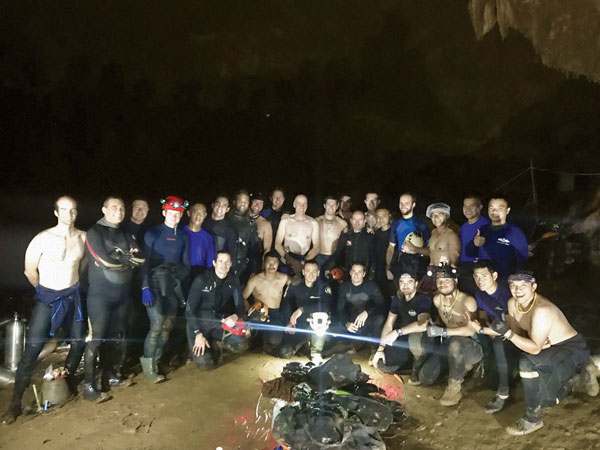
Any other stories?
It’s amazing how many individual stories there are from the event. It’s unreal to think of how many lives this effected. Even stories among us in the rescue team vary. I recently went to Eurotek and heard Rick and Dr. Harris give a presentaion. Even I learned a lot, and I was there, haha! I didn’t know that four searchers were trapped in the inital days, and Rick and John had to swim them out.
You read about the lady who owned the rice farm that lost everything in the floods [caused by the pumped out water]. The community got together and subsidized her rice so she wasn’t out of pocket. There was no shortage of community there.
When did you see the kids?
The King organized a banquet dinner to honour everyone involved. About 9000 people were there, and that was the first time I actually got to meet kids. About 75 of us they gave awards to. We were sort of sitting there at the very front, and kids were at a table right in the middle, beside us. They don’t speak any English so the conversations were short, but I went over to shake there hands and say hello. It all came full circle.
What happened after that?
Everywhere we’d go, the immigration police would pick us up and chauffeur us around. The people were very hospitable. There was a huge welcoming committee at home on the island waiting for me, too.
Then it’s back to real life. I stayed out of the water for little bit though!!
You’re definitely out of your element. I’m a diver, I dive. I’m used to being behind the camera rather than in front of it. I found it fairly awkward.
The first two weeks were filled with basic public interest, but it dies off pretty quick. There’s a second wave now with the documentaries and movies coming up. But the story has now largely been told. I spent the last couple weeks at various dive shows and met some amazing people. It’s great to get face to face with the people who are genuinely interested.
So, who would play you in the movie version?!
Some of the Thai news had me labeled as Thor with long hair covered in mud! If Chris Hemsworth wants to gain 20 pounds [9 kg] and have a non-speaking role then it’s all his!
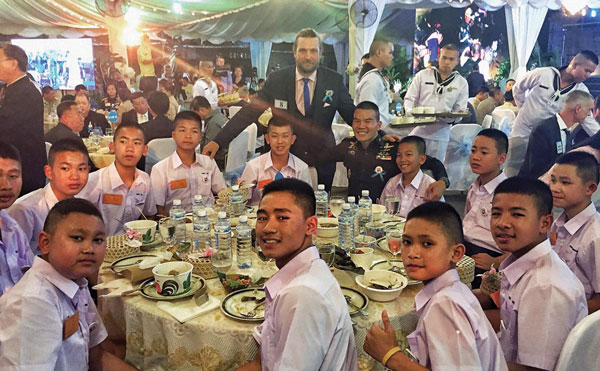
You also received some recognition in Canada?
I was pretty proud to receive the Silver Medal For Bravery from the Lieutenant Governor of British Columbia. It was quite an honour sitting beside some of the other people in that situation, too. I mean, a lot of our stuff was intense and I understand the reactions behind it, but the guy sitting next to me got the same award because he ran into a burning building and saved a whole family on his own – I just sat there and was humbled to be in the same room. My mom, being a mom, asked what it takes to get a gold medal. The guy responded, “Die.” I was more than happy with silver.
What did your mom think?!
It made up for the beer comment! My mom, brother, and aunt – my little support team – were there. My brother was pretty good to me; news crews ended up at my house when they found out there was a Canadian diver involved, so my bother took over most of the PR, so it was nice to share that day with him.

What’s next?
It’s a good story. For people genuinely interested I’m happy to tell it. The world needed a win and so did the dive community. I was simply happy to be a part of it and help where I could.
Diving has given me a life for almost fifteen years, based on the support from my family. Some aren’t so lucky. I have a few dive trips and sponsors in the works, the objective will go towards a local charity we are working with to put underprivileged kids through dive training. It will start in Vancouver, Canada, but the concept is really quite simple – get people diving.
Read Part 1 here.
2 Responses to “Erik Brown: Accounts from Thailand’s cave rescue Part 2”
Leave a Comment








Leah
Is there a way I can buy a hard print copy of this magazine featuring this particular story? Please let me know.
DIVER Editorial
Please email: mail@divermag.com with the details, and they will respond with more information. Thank you.